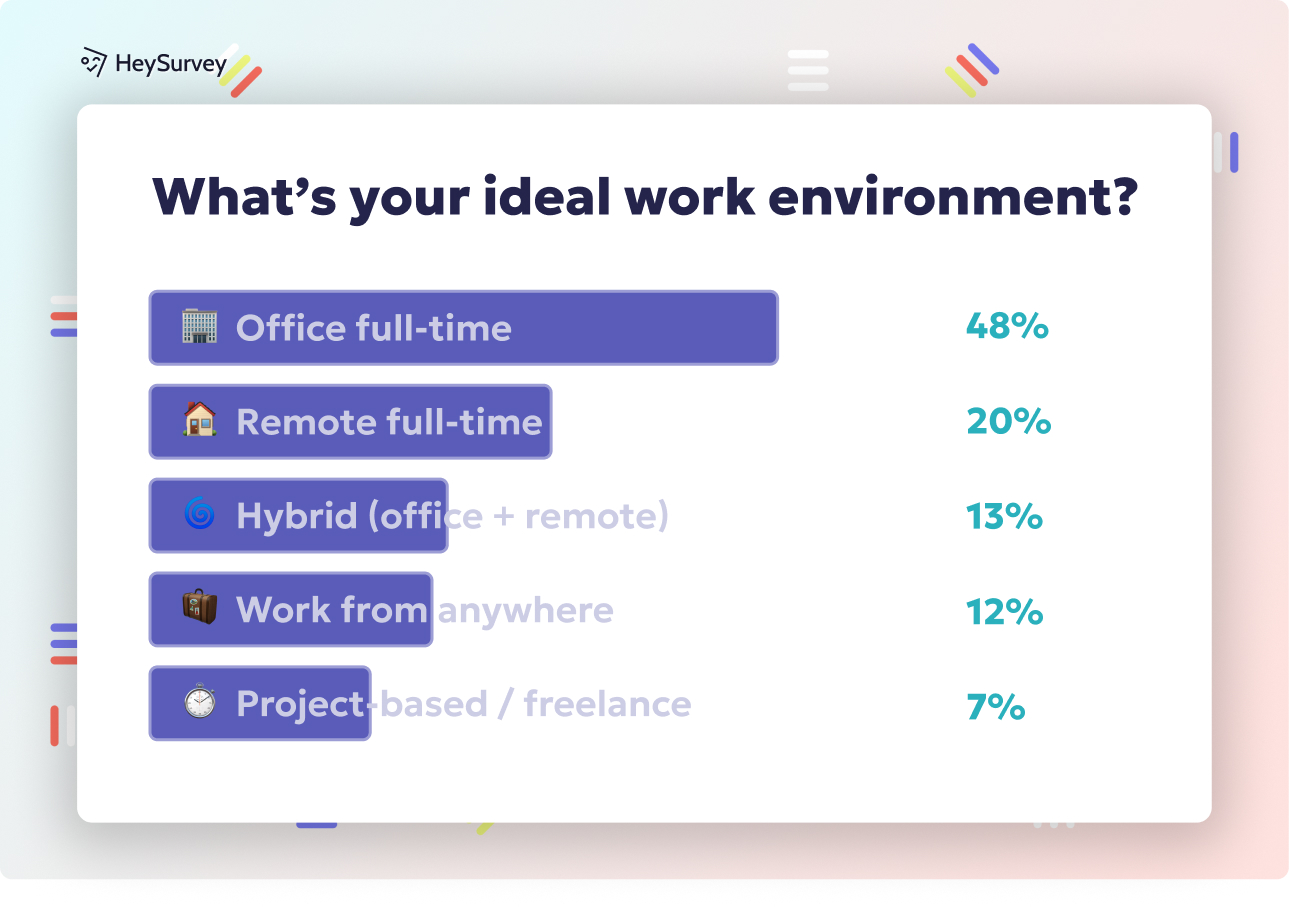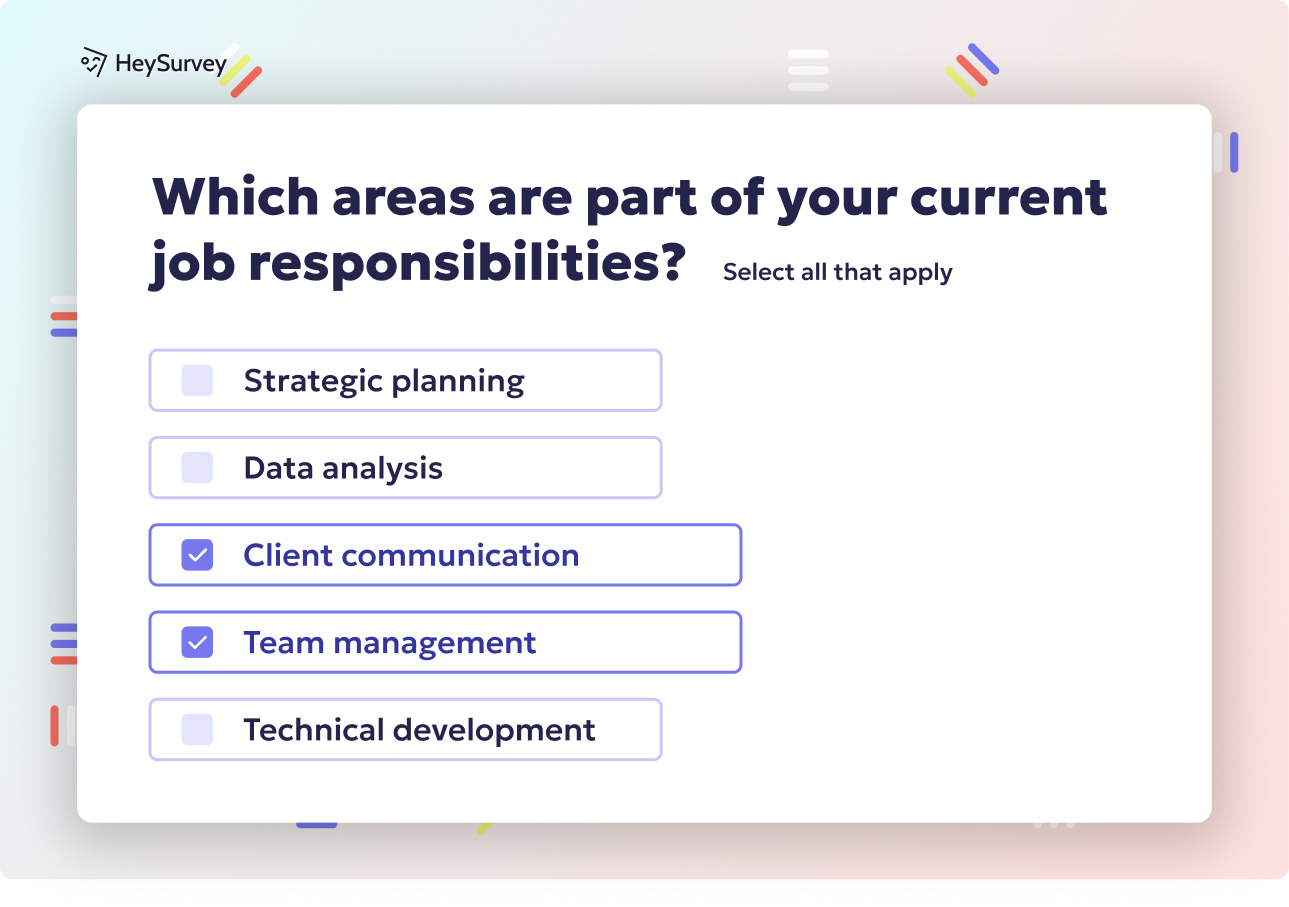29 Hiring Manager Satisfaction Survey Questions to Boost Hiring
Discover 25 hiring manager satisfaction survey questions with expert tips to improve recruiter alignment, candidate quality, and hiring speed.
Hiring Manager Satisfaction Survey Questions
Hiring manager satisfaction surveys are the secret sauce for a data-driven, high-performing talent acquisition function. At first glance, they might seem like another HR checkbox, but these surveys hold the key to optimizing recruitment ROI. Their real power lies in uncovering what recruiters, hiring managers, and candidates actually experience—good, bad, and everything in between. By regularly tapping into the honest feedback of hiring managers, organizations can surface recurring pain points, polish recruiter performance, and ultimately accelerate the journey from vacancy to valuable new team member. In this article, you’ll discover a spectrum of hiring manager satisfaction survey types, including actionable sample questions and pro tips for boosting response rates and results. Whether you’re looking to evaluate post-interview processes, recruiter collaboration, time-to-fill, candidate fit, or onboarding impact, your blueprint for sharper surveys starts here.
Introduction: Why Hiring-Manager Satisfaction Surveys Matter
Hiring isn’t just about filling a spot, it’s about building momentum for the whole business. When you forget to listen to hiring manager feedback, you risk a string of headaches—think managers grumbling about irrelevant candidate slates, roles sitting open for ages, or recruiters and hiring managers out of sync. In fact, studies have shown the average time-to-fill in the U.S. runs about 42 days, with quality-of-hire cited as a top-three talent acquisition challenge for 80% of HR leaders. Savvy HR and Talent Acquisition teams know that the right time to deploy these surveys is after each hire, on a quarterly basis, or when a big hiring sprint wraps up. Get ready—a few well-worded questions can boost retention, clarify recruiter expectations, and transform your next hiring cycle from sluggish to seamless.
Implementing hiring manager satisfaction surveys can enhance recruitment efficiency, improve candidate quality, and strengthen collaboration between hiring managers and recruiters. (recruitee.com)

How to Create a Hiring Manager Satisfaction Survey with HeySurvey in 3 Easy Steps
If you’re new to HeySurvey, don’t worry! Creating your first hiring manager satisfaction survey is simpler than you might think. Just follow these three straightforward steps—and you’ll have a polished, live survey ready to collect valuable feedback in no time.
Step 1: Create a New Survey
- Head over to HeySurvey’s dashboard and click Create New Survey.
- Choose whether to start from scratch with an empty sheet or pick a pre-built template if you want a head start.
- Give your survey an internal name (something like “Hiring Manager Satisfaction Q1”) so you can find it easily later.
- Once created, you’ll enter the Survey Editor, your workspace for shaping the questions and flow.
Step 2: Add Your Questions
- Click the Add Question button at the top or between existing questions.
- Select the question type you want—likely a mix of Choice (single or multiple), Scale, and maybe some Text questions for open feedback.
- Insert the sample questions related to hiring manager satisfaction, such as rating candidate slate relevance or recruiter communication.
- Use the markdown formatting features to highlight key points or organize options neatly.
- Mark questions as required if you want to ensure managers answer them before submitting.
- Don’t forget to preview your survey occasionally by hitting the Preview button to see how it looks from the respondent’s perspective.
Step 3: Publish Your Survey
- When you’re happy with your questions and design, click Publish to make your survey live.
- HeySurvey will generate a shareable link you can email to your hiring managers or embed on internal sites.
- You’ll need a HeySurvey account to publish and access results, so make sure you’ve signed up beforehand.
- Once the survey is live, responses will be gathered in your dashboard where you can monitor participation and analyze data.
Bonus: Make Your Survey Shine and Work Smarter
After the basics, consider these extra steps to maximize impact:
- Apply Branding: Upload your company logo in the branding settings for a professional look that hires trust.
- Define Settings: Set start and end dates for the survey availability, limit total responses if needed, and add a custom redirect page once managers submit their feedback.
- Use Branching: Skip irrelevant questions based on earlier answers by setting up survey branches. For example, if a manager says scheduling was smooth, bypass questions about scheduling problems.
With HeySurvey, these options are easily accessible in the settings and designer sidebars, giving you flexibility without complexity.
Ready for a shortcut? Click the button below to open a ready-made Post-Interview Hiring Manager Satisfaction Survey template and start customizing for your team in minutes!
Survey Type 1 – Post-Interview Hiring Manager Satisfaction Survey
Why & When to Use This Survey
Deploying a post-interview hiring manager satisfaction survey unlocks real-time, actionable insights at the most critical stage—immediately after the interview round. Capturing fresh feedback after each interview ensures you can tweak processes, coach recruiters, and adjust candidate slates on the fly. For high-volume or mission-critical openings, these surveys keep your foot on the gas.
This approach ensures: * Immediate recall of what worked or flopped during interviews. * Quick pivots on recruiter guidance if the candidate slate misses the mark. * Improved overall candidate experience by eliminating repeat pain points.
Post-interview feedback goes beyond guesswork. It’s your fast pass to candidate slate quality insights, revealing whether your recruiters are surfacing stars or just running through the motions. Plus, it’s an excellent barometer for your interview logistics—did resumes and prep guides land on time? Did scheduling feel like solving a Rubik’s cube?
5 Sample Questions
How satisfied were you with the relevance of the candidate shortlist?
Did you receive candidate résumés and interview guides in a timely manner?
How effectively did the recruiter communicate role requirements to candidates?
What obstacles, if any, did you face during scheduling?
On a scale of 1–10, how confident are you that the current pipeline will fill the role?
When building your survey, provide: * A 1–5 or 1–10 scale for quantitative items, * Room for open-text input on obstacles or pipeline confidence, * At least one question focusing on overall experience and process friction.
Post-interview hiring manager survey data arms HR with fast fixes for future rounds. These insights make sure every next step is sharper than the last.
Implementing post-interview hiring manager satisfaction surveys can significantly enhance recruitment processes by identifying areas for improvement and ensuring a seamless hiring experience. (proprofssurvey.com)
Survey Type 2 – Recruiter Partnership Satisfaction Survey
Why & When to Use This Survey
Even the slickest talent acquisition operation stumbles without robust recruiter–hiring manager alignment. That’s why organizations roll out a recruiter partnership satisfaction survey every quarter. By treating this survey like a relationship net promoter score (NPS), you’ll flag fractures before they become full-blown problems.
Launching this survey periodically helps: * Uncover whether your recruiter truly “gets” your talent needs. * Gauge transparency—are status updates clear or cryptic? * Prompt tweaks to keep recruiter partnerships humming along.
Collaborative hiring is a dance, not a solo. When recruiters and hiring managers aren’t in step, you wind up with mismatched candidates, slow search cycles, and plenty of finger-pointing. These surveys spotlight what’s working—and what can be improved—so your team doesn’t miss a beat.
5 Sample Questions
How well does your recruiter understand your talent needs?
Rate the clarity and frequency of status updates you receive.
How proactive is the recruiter in sourcing diverse candidates?
What could improve the partnership moving forward?
Would you recommend this recruiter to another hiring manager? Why/why not?
Mixing rating-scale answers with open-text space lets you capture nuanced recruiter feedback. It also offers benchmarks for improving NPS over time.
Embed these questions in your regular survey cycle, and watch recruiter satisfaction—and hiring results—move up and to the right.
Survey Type 3 – Time-to-Fill Process Review Survey
Why & When to Use This Survey
Time-to-fill can be a recruiter’s arch-nemesis. Whenever a role lingers longer than your benchmark days or when quarter-end stats reveal lagging pipelines, it’s time to break out the time-to-fill process review survey. This feedback tool cuts through the noise to pinpoint exactly where the hiring funnel slows to a crawl.
Use this survey to diagnose: * Whether approvals, screenings, or panel scheduling are the main culprits. * Engineer a smoother handoff between recruiters and managers. * Unravel “hidden” delays, whether caused by slow assessment tools or stretched interview panels.
Don’t wait for hiring managers to complain or for star candidates to slip away. Proactively surveying on time-to-fill process pain ensures your hiring velocity stays competitive.
5 Sample Questions
Which stage in the hiring funnel feels longest to you?
Were requisition approvals completed in a reasonable timeframe?
How satisfied are you with interview panel availability?
Did any assessment tools slow the process?
What is an acceptable time-to-fill for this role type from your perspective?
By tracking which survey items consistently score low, your team can: * Pinpoint specific delays by stage or department, * Revisit bottleneck-prone steps like approvals or assessments, * Set agile, role-specific time-to-fill KPIs.
This approach takes time-to-hire data out of the spreadsheet and turns it into action—all with a few targeted questions.
A study by Ideal found that the hiring manager review stage accounts for 37% of the total time-to-fill, making it the most significant bottleneck in the hiring process. (ideal.com)
Survey Type 4 – Candidate Quality & Fit Feedback Survey
Why & When to Use This Survey
You’ve made a hire—congrats! But the real question is: did you land the right person? Enter the candidate quality and fit feedback survey, an essential pulse check after the new talent’s first 90 days or when a critical role closes. This tool aligns your sourcing and screening with what actually drives team success.
When you deploy this survey: * Compare the new hire’s skills and cultural fit with original expectations. * Find out which resume traits or interview strengths signaled future performance. * Tighten role requirements for future hires—no more “misses.”
The feedback loop is especially powerful here. It lets hiring managers reflect on the journey from résumé to ramp-up, and helps recruiters refine their radar for top talent.
5 Sample Questions
How well does the new hire meet the technical requirements stated?
Evaluate cultural fit and team integration so far.
Rate the new hire’s performance against expectations at the 90-day mark.
Which candidate attributes were most predictive of success?
What would you adjust in the role profile for future openings?
Collect these responses to: * Map which candidate attributes lead to “keepers”, * Rework job ads and interview rubrics to focus on real predictors, * Move beyond “gut feel” and into data-driven hiring.
Sharpen your recruiting ROI by learning directly from your own wins—and near-misses.
Survey Type 5 – Onboarding Feedback from Hiring Managers
Why & When to Use This Survey
It’s not enough to sign the offer letter—stellar onboarding is the true test of a seamless hire. A hiring manager onboarding feedback survey delivered 30–60 days after the start date helps you measure how well the new employee hits the ground running and where gaps emerge between HR’s checklist and the team’s reality.
Deploying this feedback form uncovers: * Whether new hires get the tools, access, and info they need on day one. * If the team’s training timeline matches the onboarding program’s promises. * Where additional support or resources could power up productivity even faster.
Too often, HR teams high-five after orientation, only for managers to face weeks of confusion, missing equipment, or mismatched training. Onboarding feedback bridges the gap between HR and the manager's in-the-trenches view.
5 Sample Questions
How prepared was the new hire on day one (equipment, access, knowledge)?
Did the onboarding schedule align with your team’s needs?
How clear were role expectations communicated to the new hire?
Rate the usefulness of HR and training resources provided.
What additional support would accelerate productivity?
By reviewing these answers, HR uncovers: * Patterns in onboarding hiccups, * Opportunities to tailor resources or training to specific roles, * Best practices to support new hires both company-wide and with each distinct team.
Turn onboarding feedback into a springboard for new hire success.
How to Capture, Distribute & Analyze Hiring-Manager Survey Data
The greatest survey won’t help if responses go missing or data sits in a dusty spreadsheet. Savvy HR teams use a mix of ATS plug-ins, smart email links, and mobile-ready surveys to get their questions into busy managers’ hands. Choose the channel that leaders actually check, but don’t bombard with reminders—one friendly nudge, then move on.
Getting high response rates boils down to: * Keeping surveys brief—five questions, tops. * Timing them so they don’t clash with peak project time. * Ensuring manager feedback is anonymous (so they spill the tea). * Securing exec buy-in to make participation “the norm.”
Distribute hiring manager surveys just-in-time: right after interviews, quarterly check-ins, or after onboarding, not as a surprise. Use ATS or HRIS tools to automate survey sends and track completions by department.
For data analysis, don’t rely on gut feel. Build dashboards that segment results by: * Department or job class (sales, engineering, etc.), * Survey timing (mid-quarter vs. post-hiring spike), * Trends over time (“Is candidate slate quality getting better?”).
Calculate Net Satisfaction Scores on each survey type, then review them in team huddles. Data visibility encourages action—bookmark your HR analytics dashboard!
Dos and Don’ts: Best Practices for High-Impact Hiring-Manager Surveys
Getting actionable feedback (not just survey fatigue) hinges on survey design best practices. Here’s how to nail your next hiring manager survey.
Dos
- Do keep surveys short—no more than five key questions.
- Do time surveys for right after relevant events (interview round, close of search, onboarding milestone).
- Do close the feedback loop: share aggregate results and planned actions.
- Do align with hiring KPIs—link survey outcomes to business goals like retention, time-to-fill, or quality-of-hire.
- Do ensure data privacy and communicate that responses are confidential.
Don’ts
- Don’t ask double-barreled questions (“Was the recruiter helpful and prompt?”—pick one!).
- Don’t ignore negative feedback—that’s your playbook for improvement!
- Don’t send surveys in the middle of quarterly targets or year-end sprints.
- Don’t overload forms with open-ended questions—mix in clear, simple scales.
- Don’t skip benchmarking—compare to last quarter, last year, or industry norms to show progress.
Strong surveys make participation quick, the value visible, and trust explicit. These steps guarantee the highest-impact hiring manager surveys deliver steady, actionable data every cycle.
Conclusion & Next Steps
Each survey type showcased here serves as a lever to elevate recruiter performance, boost candidate quality, and trim hiring delays. Implementing just one new feedback loop this quarter can illuminate blind spots and unlock real ROI. So why not start small—pilot your favorite survey type and watch your hiring process sharpen. For an extra boost, download our free survey template or reach out to our HR consulting services to get moving. Your next best hire (and happier hiring managers) are just a few questions away.
Related Hiring Survey Surveys

25 Quality of Hire Survey Questions to Measure New-Hire Success
Discover 30 expert quality of hire survey questions across 6 surveys to accurately measure new-hi...

